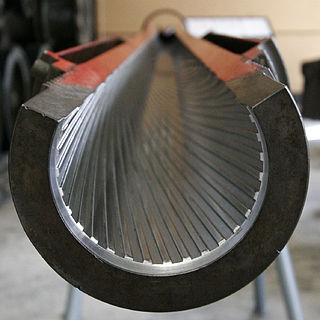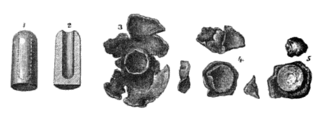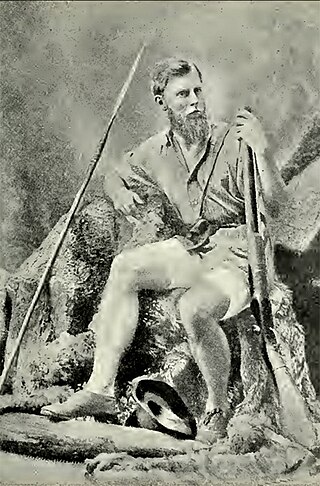Related Research Articles

A firearm is any type of gun that uses an explosive charge and is designed to be readily carried and operated by an individual. The term is legally defined further in different countries.

A rifle is a long-barreled firearm designed for accurate shooting and higher stopping power, with a barrel that has a helical or spiralling pattern of grooves (rifling) cut into the bore wall. In keeping with their focus on accuracy, rifles are typically designed to be held with both hands and braced firmly against the shooter's shoulder via a buttstock for stability during shooting. Rifles have been used in warfare, law enforcement, hunting and target shooting sports.

A cartridge, also known as a round, is a type of pre-assembled firearm ammunition packaging a projectile, a propellant substance and an ignition device (primer) within a metallic, paper, or plastic case that is precisely made to fit within the barrel chamber of a breechloading gun, for convenient transportation and handling during shooting. Although in popular usage the term "bullet" is often used to refer to a complete cartridge, the correct usage only refers to the projectile.
A muzzleloader is any firearm in which the user loads the projectile and the propellant charge into the muzzle end of the gun. This is distinct from the modern designs of breech-loading firearms, in which user loads the ammunition into the breech end of the barrel. The term "muzzleloader" applies to both rifled and smoothbore type muzzleloaders, and may also refer to the marksman who specializes in the shooting of such firearms. The firing methods, paraphernalia and mechanism further divide both categories as do caliber.

Rifling is the term for helical grooves machined into the internal surface of a firearms's barrel for imparting a spin to a projectile to improve its aerodynamic stability and accuracy. It is also the term for creating such grooves.

In guns, particularly firearms, but not artillery, where a different definition may apply, caliber is the specified nominal internal diameter of the gun barrel bore – regardless of how or where the bore is measured and whether the finished bore matches that specification. It is measured in inches or in millimeters. In the United States it is expressed in hundredths of an inch; in the United Kingdom in thousandths; and elsewhere in millimeters. For example, a US "45 caliber" firearm has a barrel diameter of roughly 0.45 inches (11.43mm). Barrel diameters can also be expressed using metric dimensions. For example, a "9 mm pistol" has a barrel diameter of about 9 millimeters. Since metric and US customary units do not convert evenly at this scale, metric conversions of caliber measured in decimal inches are typically approximations of the precise specifications in non-metric units, and vice versa.

A rim-fire is a type of metallic cartridge used in firearms where the primer is located within a hollow circumferential rim protruding from the base of its casing. When fired, the gun's firing pin will strike and crush the rim against the edge of the barrel breech, sparking the primer compound within the rim, and in turn ignite the propellant within the case. Invented in 1845 by Louis-Nicolas Flobert, the first rimfire metallic cartridge was the .22 BB Cap cartridge, which consisted of a percussion cap with a bullet attached to the top. While many other different cartridge priming methods have been tried since the early 19th century, such as teat-fire and pinfire, only small caliber rimfire cartridges have survived to the present day with regular use. The .22 Long Rifle rimfire cartridge, introduced in 1887, is by far the most common ammunition found in the world today in terms of units manufactured and sold.

A breechloader is a firearm in which the user loads the ammunition from the breech end of the barrel, as opposed to a muzzleloader, in which the user loads the ammunition from the (muzzle) end of the barrel.

A gun barrel is a crucial part of gun-type weapons such as small firearms, artillery pieces, and air guns. It is the straight shooting tube, usually made of rigid high-strength metal, through which a contained rapid expansion of high-pressure gas(es) is used to propel a projectile out of the front end (muzzle) at a high velocity. The hollow interior of the barrel is called the bore, and the diameter of the bore is called its caliber, usually measured in inches or millimetres.

An elephant gun is a large caliber gun, rifled or smoothbore, originally developed for use by big-game hunters for elephant and other large game. Elephant guns were black powder muzzle-loaders at first, then black powder express rifles, then later used smokeless powder cartridges.
Internal ballistics, a subfield of ballistics, is the study of the propulsion of a projectile.

A shotgun slug is a heavy projectile made of lead, copper, or other material and fired from a shotgun. Slugs are designed for hunting large game, and other uses, particularly in areas near human population where their short range and slow speed helps increase safety margin. The first effective modern shotgun slug was introduced by Wilhelm Brenneke in 1898, and his design remains in use today. Most shotgun slugs are designed to be fired through a cylinder bore, improved cylinder choke, rifled choke tubes, or fully rifled bores. Slugs differ from round ball lead projectiles in that they are stabilized in some manner.
A rifled musket, rifle musket, or rifle-musket is a type of firearm made in the mid-19th century. Originally the term referred only to muskets that had been produced as a smoothbore weapon and later had their barrels replaced with rifled barrels. The term later included rifles that directly replaced, and were of the same design overall as, a particular model of smoothbore musket.

The term express was first applied to hunting rifles and ammunition beginning in the mid-19th century, to indicate a rifle or ammunition capable of higher than typical velocities. The early express cartridges used a heavy charge of black powder to propel a lightweight, often hollow point bullet, at high velocities to maximize point blank range. Later the express cartridges were loaded with nitrocellulose-based gunpowder, leading to the Nitro Express cartridges, the first of which was the .450 Nitro Express.

The double rifle, also known as a double-barreled rifle, is a rifle with two barrels mounted parallel to each other that can be fired simultaneously or sequentially in quick succession. Synonymous with big game hunting found primarily in Africa and Asia, the double rifle is a sporting weapon with very little military heritage.

The M1819 Hall rifle was a single-shot breech-loading rifle designed by John Hancock Hall, patented on May 21, 1811, and adopted by the U.S. Army in 1819. It was preceded by the Harpers Ferry M1803. It used a pivoting chamber breech design and was made with either flintlock or percussion cap ignition systems. The years of production were from the 1820s to the 1840s at the Harpers Ferry Arsenal. This was the first breech-loading rifle to be adopted in large numbers by any nation's army, but not the first breech-loading military rifle – the Ferguson rifle was used briefly by the British Army in the American Revolutionary War. The Hall rifle remained overshadowed by common muskets and muzzleloading rifles which were still prevalent until the Civil War. The early flintlocks were mostly converted to percussion ignition.
A muzzle-loading rifle is a muzzle-loaded small arm that has a rifled barrel rather than a smoothbore, and is loaded from the muzzle of the barrel rather than the breech. Historically they were developed when rifled barrels were introduced by the 1740ies, which offered higher accuracy than the earlier smoothbores. The American longrifle evolved from the German "Jäger" rifle; a popularly recognizable form of the "muzzleloader" was the Kentucky Rifle. Although by definition they must be reloaded after each shot in a time-consuming fashion, they are still produced for hunting.
The following are terms related to firearms and ammunition topics.
The 8 bore, also known as the 8 gauge, is an obsolete caliber used commonly in the 19th-century black-powder firearms for hunting large dangerous game.

Four bore or 4 bore is a black powder caliber of the 19th century, used for the hunting of large and potentially dangerous game animals. The specifications place this caliber between the larger 2 bore and the smaller 6 bore rifles. This caliber was the quintessential elephant gun caliber of the black powder safari rifles. The caliber was also used for the Coffman cartridges used for starting large aero engines such as the Rolls-Royce Griffon as used in the later Marks of Supermarine Spitfire.
References
- 1 2 3 Ganyana, "The Giant Bores 4 and 6", www.shakariconnection.com, retrieved January 2017.
- 1 2 3 Sir Samuel White Baker, Wild Beasts and Their Ways: Reminiscences of Europe, Asia, Africa and America, Vol 1, London, 1891.
- ↑ Frederick Courteney Selous, A Hunter's Wanderings in Africa; being a narrative of nine years spent amongst the game of the far interior of South Africa, Bentley & Son, London, 1881.